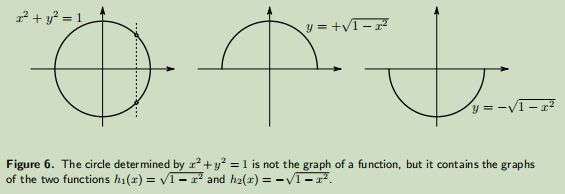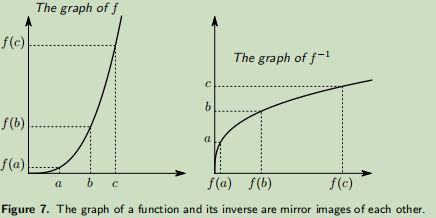MATH 221 Inverse Functions And Implicit Functions Assignment
- Subject Code :
MATH-221
- Country :
Australia
For many functions the rule which tells you how to compute it is not an explicit formula, but instead an equation which you still must solve. A function which is defined in this way is called an implicit function.
4.1. Example.
One can defifine a function f by saying that for each x the value of f(x) is the solution y of the equation
X^2 + 2y ? 3 = 0.
In this example you can solve the equation for y,
y = 3-x^2/ 2
Thus we see that the function we have defifined is f(x) = (3 -x2)/2.
Here we have two definitions of the same function, namely
y = f(x) is defined by x2 + 2y -3 = 0, and
f is defined by f(x) = (3 -x2)/2.
The first definition is the implicit defifinition, the second is explicit. You see that with an implicit function it isnt the function itself, but rather the way it was defined thats implicit.
4.2. Another example: domain of an implicitly defined function.
Define g by saying that for any x the value y = g(x) is the solution of x^2 + xy ? 3 = 0.
Just as in the previous example one can then solve for y, and one finds that g(x) = y = 3 -x^2 x
Unlike the previous example this formula does not make sense when x = 0, and indeed, for x = 0 our rule for g says that g(0) = y is the solution of 02 + 0 y -3 = 0, i.e. y is the solution of 3 = 0.
That equation has no solution and hence x = 0 does not belong to the domain of our function g

4.3. Example: the equation alone does not determine the function.
Define y = h(x) to be the solution of x^2 + y^2 = 1.
If x > 1 or x < -1 then x2 > 1 and there is no solution, so h(x) is at most defined when -1
X^2 + y^2 = 1 y = p 1 x^2 or y = p 1 x^2.
The rule which defines a function must be unambiguous, and since we have not specified which of these two solutions is h(x) the function is not defined for ?1 < x>
One can fix this by making a choice, but there are many possible choices. Here are three possibilities:
h1(x) = the non negative solution y of x2 + y2 = 1
h2(x) = the non positive solution y of x2 + y2 = 1
h3(x) = ( h1(x) when x < 0>
4.4. Why use implicit functions?
In all the examples we have done so far we could replace the implicit description of the function with an explicit formula. This is not always possible or if it is possible the implicit description is much simpler than the explicit formula. For instance, you can define a function f by saying that y = f(x) if and only if
y3 + 3y + 2x = 0.
This means that the recipe for computing f(x) for any given x is solve the equation y3 + 3y + 2x = 0.
E.g. to compute f(0) you set x = 0 and solve y3 + 3y = 0. The only solution is y = 0, so f(0) = 0. To compute f(1) you have to solve y3 + 3y + 2 1 = 0, and if youre lucky you see that y = ?1 is the solution, and f(1) = ?1.
In general, no matter what x is, the equation (1) turns out to have exactly one solution y (which depends on x, this is how you get the function f). Solving (1) is not easy. In the early 1500s Cardano and Tartaglia discovered a formula1 for the solution. Here it is:
y = f(x) = 3q -x + p 1 + x2 -3q x + p 1 + x2.
The implicit description looks a lot simpler, and when we try to differentiate this function later on, it will be much easier to use implicit differentiation than to use the Cardano-Tartaglia formula directly.
4.5. Inverse functions.
If you have a function f, then you can try to define a new function f -1 , the so-called inverse function of f, by the following prescription:
For any given x we say that y = f -1(x) if y is the solution to the equation f(y) = x. So to find y = f -1(x) you solve the equation x = f(y). If this is to define a function then the prescription (2) must be unambiguous and the equation f(y) = x has to have a solution and cannot have more than one solution.

4.6. Examples.
Consider the function f with f(x) = 2x + 3. Then the equation f(y) = x works out to be 2y + 3 = x and this has the solution y = x ? 3 /2
So f -1(x) is defined for all x, and it is given by f -1(x) = (x -3)/2.
Next we consider the function g(x) = x2 with domain all positive real numbers. To see for which x the inverse g?1(x) is defined we try to solve the equation g(y) = x, i.e. we try to solve y2 = x. If x < 0 y=x xss=removed>
So we see that g-1(x) is defifined for all nonnegative real numbers x, and that it is given by g-1(x) = x.
4.7. Inverse trigonometric functions.
The familiar trigonometric functions Sine, Cosine and Tangent have inverses which are called arcsine, arccosine and arctangent.
y = f(x)
x = f ?1(y)
y = sin x
(??/2 ? x ? ?/2)
x = arcsin(y) (?1 ? y ? 1)
y = cos x
(0 ? x ? ?)
x = arccos(y) (?1 ? y ? 1)
y = tan x
(??/2 < x> x = arctan(y)
The notations arcsin y = sin?1 y, arccos x = cos?1 x, and arctan u = tan?1 u are also commonly used for the inverse trigonometric functions. We will avoid the sin?1 y notation because it is ambiguous. Namely, everybody writes the square of sin y as Replacing the 2s by ?1s would lead to sin y 2 = sin2 y.
arcsin y = sin?1 y ?!?= sin y?1 = 1 sin y , which is not true!
Are you struggling to keep up with the demands of your academic journey? Don't worry, we've got your back! Exam Question Bank is your trusted partner in achieving academic excellence for all kind of technical and non-technical subjects.
Our comprehensive range of academic services is designed to cater to students at every level. Whether you're a high school student, a college undergraduate, or pursuing advanced studies, we have the expertise and resources to support you.
To connect with expert and ask your query click here Exam Question Bank

